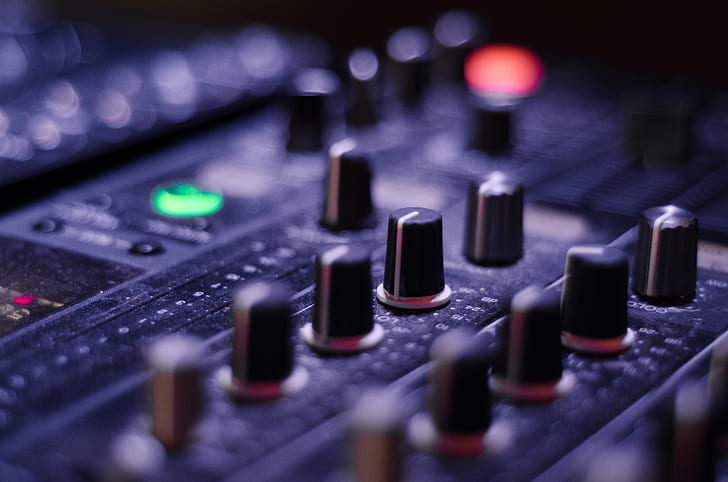
Editing, mixing, and mastering our final audio output enables us to achieve a great sound on all speakers, phones, platforms, and other devices.
Over 60,000 tracks are uploaded on Spotify every day, which means that in order to stand out in this massive ‘database’, your track has to be as best as it can possibly be. It’s those first seconds that will catch the attention of your listener or will not.
There’s a chance that if the listener hears poor quality in your track, for example, poorly balanced vocals or sound that is regularly clipping, they are more likely to skip the tune.
If you’re not yet familiar with editing, mixing, or mastering, it may be worth investing in this area, to learn more and ensure your output is the best quality possible. Professionally done tracks = a professional image.
After recording your music, there is a 3 step process to finalise the tune:
There are a lot of different ways to work on your recording; for example, some musicians and composers choose to edit the track individually and leave mixing and mastering to a sound engineer. It is also possible to choose a different sound engineer for each of the 3 steps.
Some artists might choose to self-produce in order to maintain their artistic control and direction over their sound, while others will decide to work in collaboration with different producers so that producers would bring new and fresh ideas into their work.
Audio Editing:
Audio editing is the process of modifying audio to change its length, speed, volume, tone etc – it allows you to adapt, change, and manipulate your recorded output in a multitude of ways.
Some basic audio editing can be:
- Removing unwanted sounds, such as cough, phone ringing or unnecessary breaths
- Add a different intro or outro
- Slightly moving instruments so that they all play exactly on the beat
- Connect different audio takes and make it as one, etc.
Mixing:
Mixing is the process of putting together numerous layers of audio to create a single finished sound. But to put it simply, it’s the technique for ensuring that all the audio tracks of a tune or musical work, sound connected and balanced together.
Mixing can include:
-
- Creating a great sound of each instrument
- Creating a combined ‘mix’ sound of all instruments together
- Balancing levels – refers to the literal level of each individual track and specific sections, or even individual notes, within each track (this can vary from engineer to engineer with some people preferring stems, with individual note levelling already in place).
-
-
- Panning – determines where on the stereo spectrum an instrument sound will be placed as simply as left speaker / right speaker output
- Equalising – to prevent any distortion or sounds being lost sound when individual tracks are layered onto each other. It involves placing each instrument track on their correct audio frequency, so lows, highs, and mids are represented accordingly while maintaining clarity
- Compressing – it is used to reduce the dynamic range of signals with loud and quiet elements so that both can be heard clearly
- Fixing problematic frequencies – knowing where an instrument is on the frequency spectrum gives you a better understanding of frequencies in general, but it also helps to identify which instruments need more or fewer frequencies enhancement
-
-
- Adding effects – sound features such as reverb, compression, and delay are added to tracks, bringing the sounds to life. The effects can add depth, emotion in the climactic part and can just simply improve the value of your production
- Automation – a programming technique that ensures certain effects and sound features appear where they are supposed to each time the recording is played back.
Some people approach the editing of sounds in creative ways at the same time as mixing, however many mix engineers prefer to simply focus on the process of mixing – there’s a time for editing and a time for mixing, as they require a different focus/approach by the engineer. Many mix engineers simply require stems of the tracks (fixed, pre-edited, ready to go for mix).
Mastering:
Mastering is the process of taking a mixed product and preparing it for different distribution outlets. This process involves unifying the sound of a music piece, keeping continuity across an album, and preparing the track for release, among other things.
With mastering’s help, we can balance and enhance particular sounds of the mixed product. This can include:
- Equalisation
- Applying compression
- Limiting
- Stereo enhancement
- Increasing the perceived volume with minimum side effects to reach commercial loudness
Where to find professional sound engineers?
- ‘The Music Producers Guild’ association
- Be active in the music industry; attend concerts, music festivals, and other networking events as sound engineers might be looking for new artists to work with
- If you have a manager, it is a good idea to ask them if they have any connection with sound engineers that they truly trust and have previous experience with
- Ask your musician friends if they have any recommendations
- Do research about engineers and their experience in the industry
- Also bear in mind that due to the pandemic, the whole concept of remote work and now developed, and can enable us to work with people outside of our immediate area
- It’s good to ask an engineer for samples of their work, maybe even a ‘before’ and ‘after’ mix
- Ask the sound engineer to send you some previous clients testimonials
- Read reviews on the internet
You can find more information here:
What is the Difference Between Mixing and Mastering?